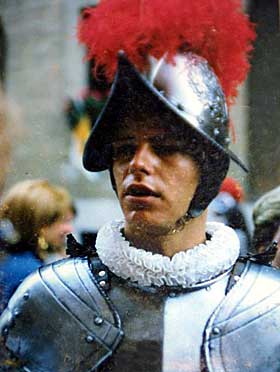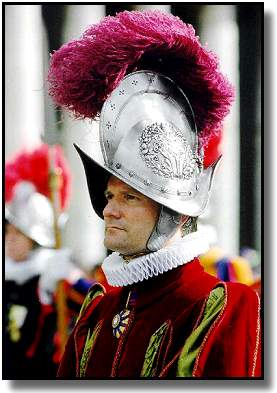Mass in a Private Chapel
On the night of Monday, May 4, 1998, Swiss Guard Lance Corporate Cedric Tornay, 23, killed Lt. Col. Alois Estermann, 43, and his Venezuelan wife, Gladys Meza Romero, 49. After they were dead, Tornay knelt, put his service revolver in his mouth and pulled the trigger. 
The Vatican handled the autopsy and investigation of the crime by itself, without asking for help from Italian officials. They considered the case clear-cut. “It was a fit of madness in a person with very peculiar psychological characteristics,” papal spokesman Joaquin Navarro-Valls said the day after the killings. “That is the only hypothesis,” a Vatican official confirmed. “There is no reason to advance any alternative.”
Estermann and his wife were given a splendid funeral, concelebrated by 16 cardinals and 30 bishops. Before the service, Pope John Paul II made a point of praying at all three caskets, which were displayed, side by side, for viewing. Tornay was given a separate funeral in a chapel in the small church of St. Anne’s.
Cardinal Secretary of State Angelo Sodano said the Requiem Mass for Col. Estermann and his wife at St. Peter’s Basillica, a rare honor for laymen. In his homily Cardinal Sodano said, “In times like these we feel above all the need to be silent.” The Estermanns had been married 16 years. They did not have any children.
The official explanation of their deaths didn’t make sense to people who knew Cedric Tornay. A flurry of articles and books followed the murders.
Bugie di sangue di Vatican (Blood Lies in the Vatican) by the “Disciples of Truth” was printed by a tiny publisher in Milan. It was reputed to have been written by a group of disaffected priests inside the Vatican. They claimed that Estermann was the victim of a struggle for control of the Swiss Guard – which had been in charge of papal security for the past five centuries – between the secretive, traditionalist Catholic movement Opus Dei and a masonic power faction ensconced in the Curia. Estermann and his wife were members of Opus Dei. The director of the Holy See press office, Joaquin Navarro-Valls, is a member as well.
John Follain, a British investigative journalist and Sunday Times correspondent for Italy and the Vatican authored City of Secrets: The Truth behind the murders at the Vatican. It was published in 2003 by William Morrow & Co. He followed several threads in trying to establish a motive for the murder. One of them was a homosexual love affair gone sour.
One source Follain met and interviewed was Italian writer and art historian, professor Massimo Lacchei. In his 1999 book, Verbum Dei, Verbum Gay (God’s Word, Gay Word) Lacchei offers ten short stories about homosexuality in the ranks of Catholic clergy. The book would have passed generally unnoticed had Lacchei not called a press conference to announce that the two Swiss guard officers in the chapter “Mass in a Private Chapel” were in fact Estermann and Tornay. In the book they appeared as “Major Jorg” and “Lieutenant Kaspar.” “This is not fiction, they (the stories) are based on real encounters” Lacchei told reporters.
The story is an account, spiced up with a couple of lewd ancedotes, of an all-male party Lacchei attended in 1997 at the home of an elderly and important Roman politician. The most eagerly awaited guests were two officers of the Swiss Guard. The story opens with the guests waiting expectantly for the two officers. They arrive, Mass is celebrated, and then, over a meal, the others sit in rapt attention as they relate the story of their relationship. 
Lacchei said he had no proof that the two Swiss Guards were lovers, but their presence at the gay brunch–and their behavior there–certainy made him think so. “They were so intimate and friendly for a subordinate and a captain,” he said. Lacchei told Follain of a second, chance meeting with Tornay in April 1998, a month before his death. Lacchei had been out walking his dog on the Via della Conciliazione, the avenue leading to St. Peter’s, when he saw Tornay and invited him home. Tornay confided that Estermann had betrayed him. He saw Estermann in an embrace with another guard in the changing rooms of the barracks. “I can forgive, but never forget” Tornay said.
A former Vatican employee told Follain a story about a homosexual chaplain of the Swiss Guard. The chaplain had several affairs with members of the corps. Whenever his advances were rebuffed, he would dress himself in civilian clothes and go to Roma Termini Station to find male prostitutes. “The ex-employee told me,” Follain related, “that a Swiss Guard plucked up his courage and complained about him to the elderly, wheelchair-bound Cardinal Andrzej Maria Deskur, who has been the pope’s closest friend ever since they studied at the seminary together. ‘We will do nothing,” Deskur muttered. ‘The chaplain is digging his own grave.'” The chaplain later died of AIDS.
As Tornay and Estermann’s relationship deteriorated, Estermann began to persecute Tornay. Estermann’s refusal to grant Cedric Tornay the Benemeriti medal for three-years service–a routine award– may have sparked the killings. Hurt and fustrated, there was no where Tornay could go to unburden or be heard. He could not discuss his relationship with Estermann. Officially, homosexuals do not exist in the Swiss Guard. “I had no choice but to hid my homosexuality,” said an ex-guardsman named Steiner. “I soon realized that the only way to survive as a homosexual in the heart of the Church was to keep it invisible.”
Tall and thin, with a short-cropped sandy beard, Steiner did not return to Switzerland after his service but stayed in Rome and opened up a flower shop. “Some people choose to live in the Vatican because for them it is like living in a giant, protective cocoon,” he said. “But for many people life in the Vatican is just a big pretense, because the truth is that under all those cassocks and the robes there are individuals who want to live normal lives, who have desires that are absolutely normal–including sexual ones.”
Vatican spokesman Vavarro-Valls took pains to deny rumors of a sexual motive for the killings. Navarro, who said he had known the Estermanns well, insisted: “”They were a model couple. The fact that they didn’t have children wasn’t important, because they dedicated their time to charity work.”
Others disagreed. “The relationship could not be other than one of a homosexual nature,” Ida Magli, a prominent anthropologist, told the Roman daily Il Messaggero. “”The Holy See wanted to close a case in a hurry, perhaps out of a need to hide a sad, worrisome truth.”

October 31st, 2010 at 5:11 pm
[…] He claimed another example of satanic behavior was the Vatican “cover-up” over the deaths in 1998 of Alois Estermann, the commander of the Swiss Guard, his wife and Corporal Cedric Tornay, a Swiss Guard, who were all found shot dead. “They covered up everything immediately,” he said. “Here one sees the rot.” (Read my post on the murders here.) […]